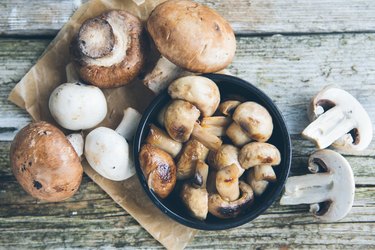
Looking to add more variety to your diet? Look no further than mushrooms.
Although sometimes classified as a vegetable, mushrooms are technically fungi and can be found in the dirt on forest floors. Because of their nutritional and health-promoting properties, they are often used in alternative medicine. And while it's not usually recommended to forage for mushrooms on your own, there are many different varieties widely available at your local grocery store or farmers market.
Video of the Day
Video of the Day
Ready to experience a variety of flavors and a nutritional punch? Try adding some of the following edible mushrooms to your diet.
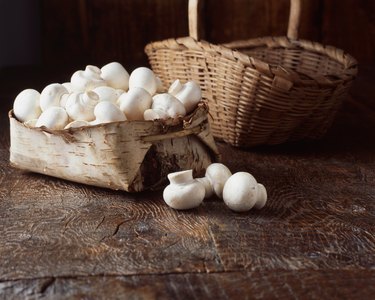
1. White Button Mushroom
The white button mushroom (Agaricus bosporus) is the most common and inexpensive variety. It has a mild flavor, making it a highly versatile mushroom for cooking. It's also a great source of fiber, vitamins C, D, B-12 and folate, according to a 2010 article in Nutrition Research.
Button mushrooms can be sliced, stuffed, diced and added to flavorful dishes or eaten raw. While they're sometimes sold by the pound, they're more often sold in eight-ounce containers.
Don't worry about the bit of dirt that can be found on the caps of these mushrooms, as it can be washed away. But avoid mushrooms that look overly dry or shiny — two signs that they are past their prime.
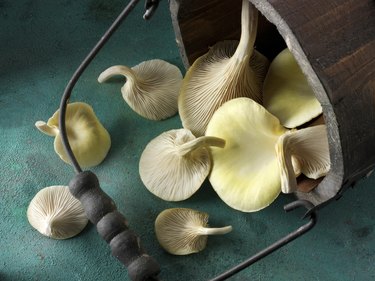
2. Oyster Mushroom
Commonly used in Asian cuisine, oyster mushrooms (Pleurotus ostreatus) also have a mild flavor. These types of mushrooms have been studied for their potential in reducing inflammation and lowering cholesterol, according to a 2015 review study published in International Journal of Microbiology.
Oyster mushrooms cook quickly, which makes them ideal for stir-frying. And while they come in several colors, such as pink and gold, you'll usually see the gray ones.
When purchasing oyster mushrooms, look for a firm mushroom that's not too dry, but also not wet. Don't choose an oyster mushroom with any discoloration or foul smell.
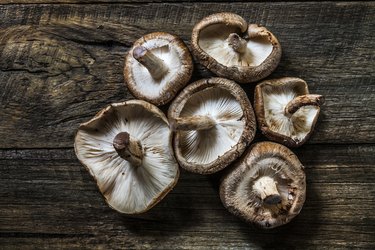
3. Shiitake Mushroom
Shiitake (Lentinula edodes) mushrooms have commonly been available in grocery stores in their dried form, but fresh shiitakes are now hitting the shelves. They're a hearty mushroom that stands up well to cooking. Shiitakes can often be substituted in recipes that call for white button mushrooms.
They may also come with some health benefits. A 2015 research study published in the Journal of the American College of Nutrition provided participants either five or 10 grams of shiitake mushrooms for four weeks and saw an improvement in immune function.
When purchasing, look for a thick, clean cap and stay away from mushrooms with caps that are slimy or glossy. Though stems are tough to eat, don't throw them out. Save them to use as flavoring in soups or stocks.
Read more: 8 Foods That Boost Your Immune System
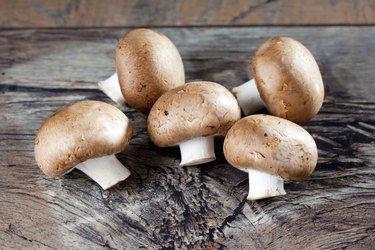
4. Cremini Mushroom
Cremini is the same species of mushrooms as the white button, Agaricus bosporus. Cremini are a more mature version of the white button and are usually sold side by side in the grocery store, sometimes as "baby bellas."
They have a heartier and richer flavor than white buttons and generally cost a bit more. Cremini mushrooms can be used as a substitute in dishes that call for white button mushrooms. Look for cremini caps that are smooth and clean, not slimy or glossy. The caps and stems are soft and edible and can be eaten cooked or raw.
According to the USDA's nutrient database, one cup of sliced cremini mushrooms has only 66 calories and will give you more than 300 milligrams of potassium. And, if they're exposed to UV light (if they were harvested from the outdoors as opposed to ones grown indoors), you'll get more than 900 IU of vitamin D, well over the RDA of 600 IU per day. Most wild mushrooms contain vitamin D, but cultivated mushrooms exposed to UV light will have a label.
Read more: 9 Ways to Help Avoid Vitamin D Deficiency
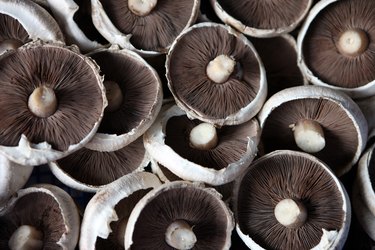
5. Portobello Mushroom
Portobello mushrooms belong to the same species as white button and cremini, but they are overgrown versions of cremini mushrooms known for their large size. Their extra time spent growing leads to a deeper and earthier-tasting mushroom.
Often used as a substitute for meat in burgers, portobello mushrooms are also used in dishes like fajitas or as a low-carb pizza crust. Look for a firm and smooth top, then turn it over and look for gills that are clean and dry. Avoid portobellos that appear either dry or overly slimy.
One large portobello mushroom is a good source of selenium, a powerful antioxidant that may play a role in cancer prevention, according to the National Institutes of Health.
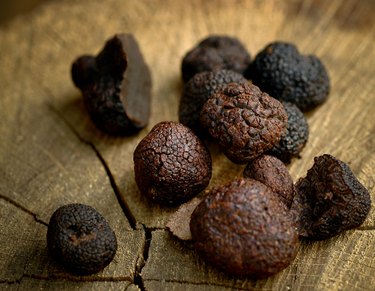
6. Truffles
Among the most luxurious (and expensive) of mushrooms, truffles fetch a high price due to their taste, aroma and difficulty in growing and harvesting. Traditionally, truffle-hunting dogs are responsible for finding them.
Although naturally found in southern and eastern Europe, truffle orchards have now been established in the United States.
Truffles are used mainly as a flavoring, offering a strong and earthy accompaniment to dips and hot dishes and used as a garnish. You can purchase them whole, sliced, as a paste or as truffle oil, which may be an inexpensive alternative that still provides truffle flavor.
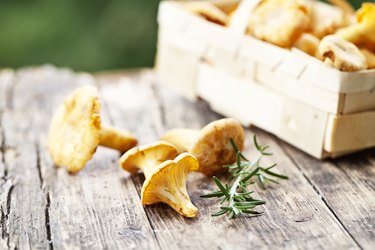
7. Chanterelle Mushroom
The golden chanterelle mushroom (Cantharellus cibarius) has been studied for its antioxidant potential, and recent research in 2017 published in the International Journal of Medicinal Mushrooms indicates they also may be beneficial in wound healing and inflammation.
Chanterelles are often light yellow or orange in color and have a funnel-like shape. The ones that have been harvested in the wild and exposed to ultraviolet light are an excellent source of vitamin D — 114 IU for one cup, according to the USDA nutrient database. When buying chanterelles, look for a mushroom that's dry, not wet, and has a fruity and fresh smell.

8. Reishi Mushroom
Reishi (Ganoderma lucidum), or lingzhi, mushrooms are widely used in alternative medicine for their healing properties. In Western medicine, they've been studied for their potential role in cancer treatment, lowering blood sugar and reducing inflammation, according to the book "Herbal Medicine: Biomolecular and Clinical Aspects."
The mushroom is long, dark in color and has a woody texture with a bitter taste. Reishi can be also consumed in coffee or tea or as a dietary supplement or powder.
There have been side effects, such as nausea and insomnia, and reishi mushroom consumption can interfere with certain medications, such as blood-thinning medications. It is recommended to talk to your health care provider before adding them to your diet.
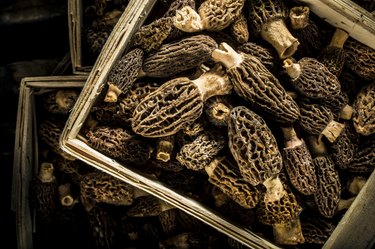
9. Morel Mushroom
Morel mushrooms (Morchella americana) are distinctive with their honeycomb top. Most morels are gathered in the wild near forested areas across the U.S. in the spring (March through May) and are rarely cultivated, making them difficult to come across for most people. But check out your local health food store, where you'll be able to find them fresh or sometimes dried.
They're used in savory dishes and are often described as having a nutty and deep umami flavor. If you find morels in a grocery or health food store, be prepared to spend a little more. Look for tops that are firm and rubbery and stay away from morels that are slimy or soft. Since they're hollow, cut them in half before cooking to make sure they're clean inside.
Morels are an excellent food source of vitamin D. One cup of morels will give you 136 IU of vitamin D, which is 23 percent of the recommended dietary allowance for an adult.
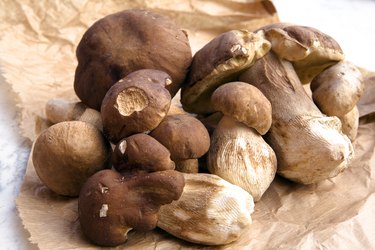
10. Porcini Mushroom
Porcini mushrooms (Boletus edulis) are a favorite to add deep, earthy mushroom flavor to risottos and soup stocks. They're not cultivated, but harvested in the wild, and are one of the most popular mushrooms in the world, according to 2014 research published in Peer J.
You'll usually find them dried, so they need to be soaked to rehydrate. When choosing dried porcini mushrooms, look for ones that are whole and not broken down into crumbs.
Porcini mushrooms are a low-calorie source of nutrients. One quarter of a cup is only 30 calories, but will give you three grams of protein and two grams of fiber.
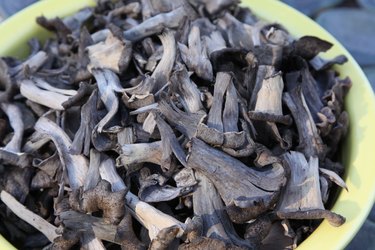
11. Black Trumpet Mushroom
Black trumpet (Craterellus cornucopioides) mushrooms are funnel-shaped mushrooms that can range from dark brown to deep black in color. They're similar in shape to chanterelle mushrooms and have no gills on the bottom, which makes them unique. These mushrooms can be hard to find in a wooded forest because of their dark color, which helps them blend into their environment.
Black trumpet mushrooms are currently being studied for their potential as a dietary source of vitamin B-12. That's potentially good news for vegans, as B-12 is most often and traditionally thought to be a nutrient only found in animal foods.
A 2014 article published in Nutrients explained that black trumpet mushrooms may provide anywhere between 1.09 to 2.65 micrograms of vitamin B-12 in approximately two pounds of mushrooms (the RDA for B-12 is 2.4 micrograms per day). While it's not likely you'd eat that many mushrooms in one day, eating a small amount of these mushrooms can contribute to vitamin B-12 intake without having to rely solely on supplements.
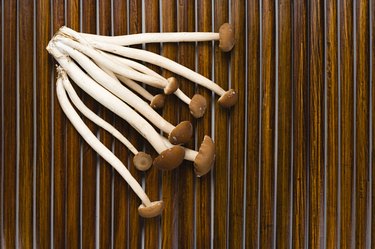
12. Enokitake Mushroom
Enokitake, or enoki, mushrooms (Flammulina velutipes) are long and thin mushrooms with miniature caps and a long stem. They're white, cream or sometimes golden in color.
If you can find enoki mushrooms, look for a firm and dry stem and clean caps. Avoid enoki mushrooms that are limp or wet. These mushrooms have a rich umami flavor and don't take long to cook, so they're perfect for a quick weeknight stir-fry.
And enoki mushrooms also have some pretty impressive potential health benefits. A 2014 study published in BioMed Research International found that enoki mushrooms are a source of antioxidants and dietary fiber, which may help reduce cholesterol levels in the blood.
What Do YOU Think?
Do you like mushrooms? Which type(s) do you usually eat? What kinds of dishes do you usually put them in? Did you know about all these other kinds of mushrooms? Will you try any of these? Share your thoughts and suggestions in the comments below!
- Nutrition Research: White button mushroom (Agaricus bisporus) lowers blood glucose and cholesterol levels in diabetic and hypercholesterolemic rats.
- International Journal of Microbiology: Edible Mushrooms: Improving Human Health and Promoting Quality Life
- Journal of Ethnobiology and Ethnomedicine: Truffle renaissance in Poland – history, present and prospects
- Journal of the American College of Nutrition: Consuming Lentinula edodes (Shiitake) Mushrooms Daily Improves Human Immunity: A Randomized Dietary Intervention in Healthy Young Adults.
- National Institutes of Health: Selenium
- National Institutes of Health: Vitamin D
- International Journal of Medicinal Mushrooms: Anti-Inflammatory and Wound-Healing Potential of Golden Chanterelle Mushroom, Cantharellus cibarius (Agaricomycetes)
- USDA Nutrient Database: Chanterelle Mushrooms
- Peer J: What’s for dinner? Undescribed species of porcini in a commercial packet
- Nutrients: Vitamin B12-Containing Plant Food Sources for Vegetarians
- BioMed Research International: Hypolipidemic and Antioxidant Activity of Enoki Mushrooms (Flammulina velutipes)
- USDA Nutrient Database for Crimini Mushrooms
- USDA Nutrient Database: Dried Porcini Mushrooms
- Wachtel-Galor, S. et al. Herbal Medicine: Bimolecular and Clinical Aspects
- Memorial Sloan Kettering Cancer Center
- Cochran Database of Systematic Reviews: Ganoderma lucidum (Reishi mushroom) for cancer treatment